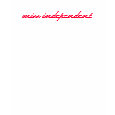For most people in the world, independence is considered a positive attribute to strive towards. But if you ask people to define independence, you may find that many have trouble explaining what independence is, and answering how it can be taught may be even trickier! It seems that for many it is a bit of a vague concept. So what exactly is independence? Why do we need it? and how can it be taught to our children?
This is a 4 part article:
Part 1: What is Independence?
Part 2: Why do we need independence?
Part 3: Why do some people find it difficult to become independent?
Part 4: Teaching Independence in Children
What is Independence?
Independence can be divided up into different categories of independence. The main categories are: Mental Independence, Behavioural Independence and Survival-based Independence.
1.) Mental Independence
An important distinction exists between independent thinking and rebellious thinking. Rebelling against someone else’s ideas means that you purposefully take the exact opposite stance to someone’s ideas, and so their ideas are ultimately controlling yours.
Mental independence is being able to think for yourself, regardless of what others think and say. It involves accessing your internal resources, listening to your inner voice, weighing up all the facts and feelings you’ve accumulated, and forming opinions based on this. Mental independence is the basis of independent thinking, independent decision-making, and leads to independent actions and behaviour.
2.) Behavioural Independence
Independent behaviour is partly based on mental independence, because it is only after you can think independently, that you can make independent choices in life from what to eat, to what you choose to do for a living. In other words, mental independence enables you to act independently.
Behavioural independence also involves freedom from control or influence of others.
3.) Survival-based Independence
The ultimate point of independence is being equipped to look after yourself to enable your successful survival. In our world, this means:
- - Financial independence: This involves earning money ourselves to allow us to buy food and pay for shelter
- - Safety-related Independence: This involves knowing how to maintain your safety, how to avoid dangerous situations and how to handle them if they occur.
- - Self-care-related Independence: This entails knowing how to look after yourself to maintain your good health and fitness, and taking care of all your needs, including social ones. Part of self-care is having a healthy social life, so there is always a healthy degree of “interdependence” that is needed even for the most independent people. We are after all social animals whose survival is connected. Without interdependence between farmers and consumers, for example, we wouldn’t have food or clothes. This give and take of “group interdependence” is necessary to enable individual independence. Being 100% self-sufficient is not the same thing as being independent. Being independent does not mean living a solitary life and never asking for help. Asking for help only becomes dependence if one person uses the other without the intention of giving anything back. Dependence also occurs when a person lacks the intention of learning to become self-sufficient.
Why do we need independence?
See Part 2: Why do we need independence?









I have been so bewildered in the past about why people rate independence so highly but now it all makes sense!